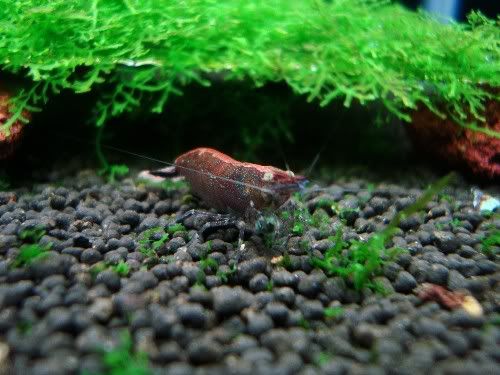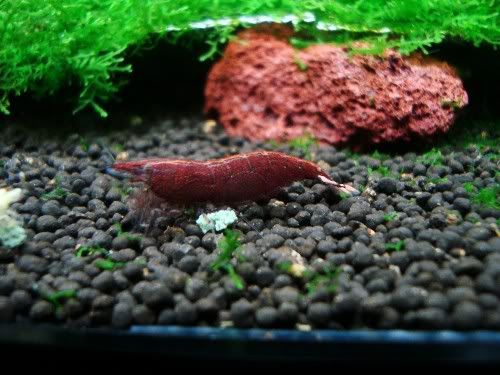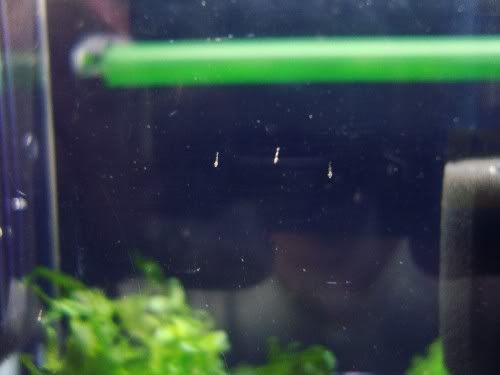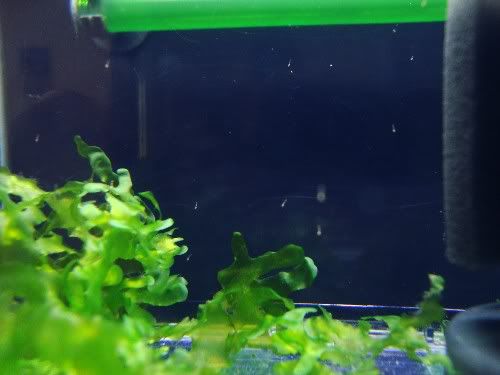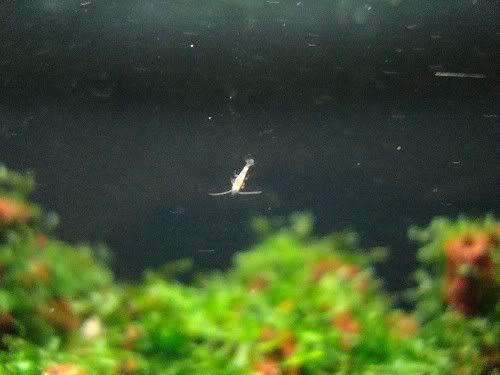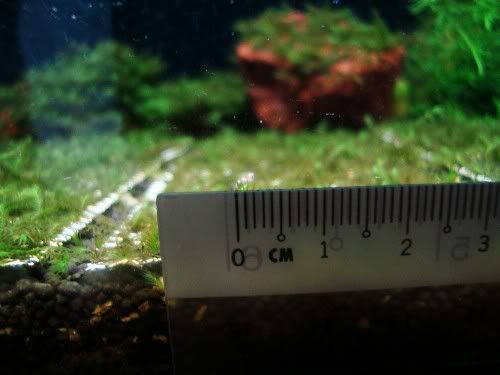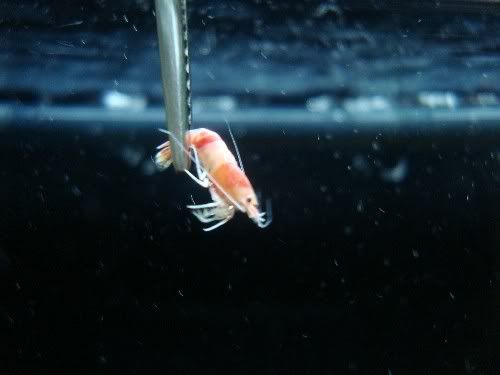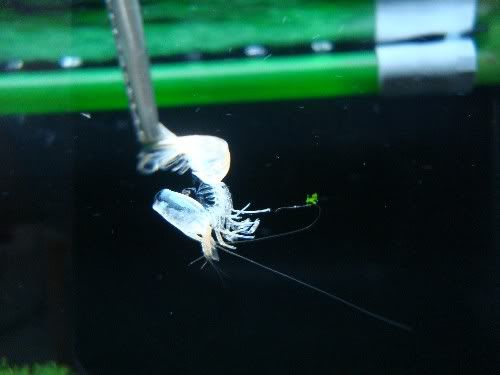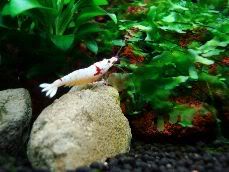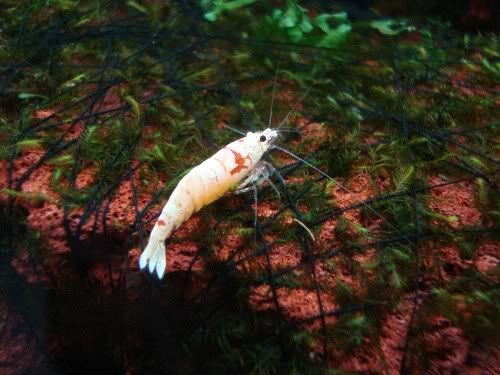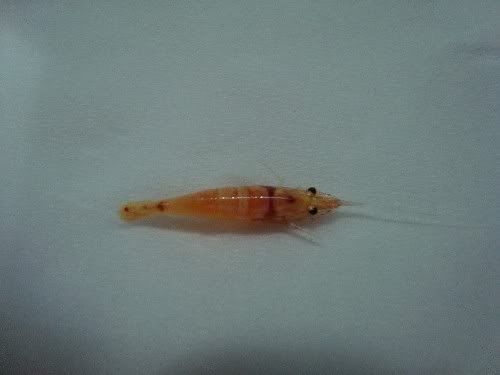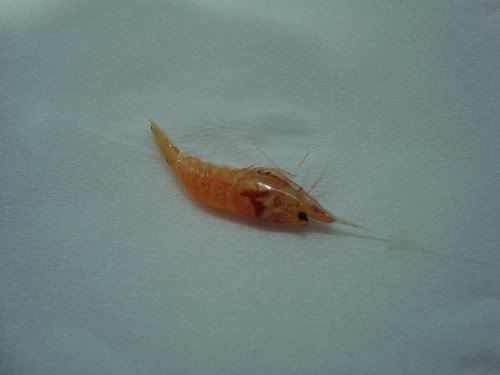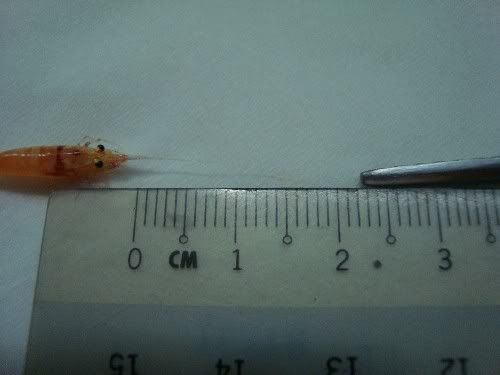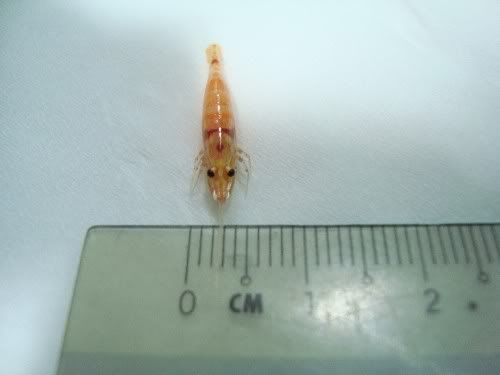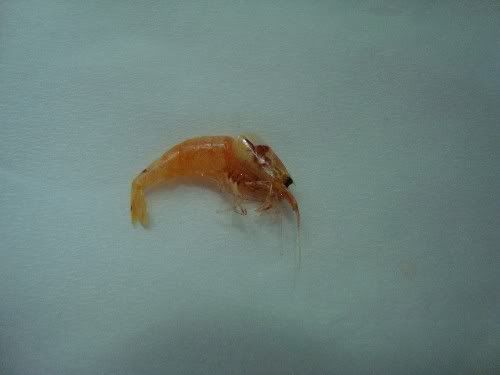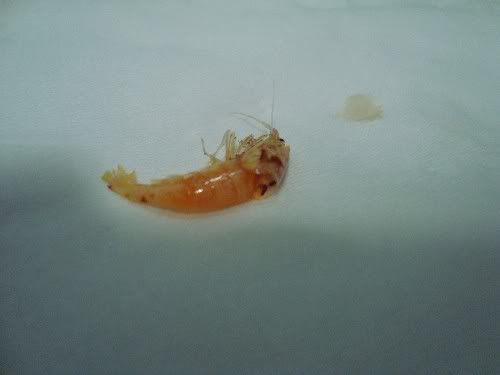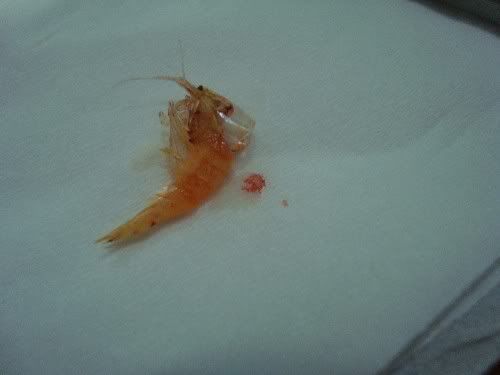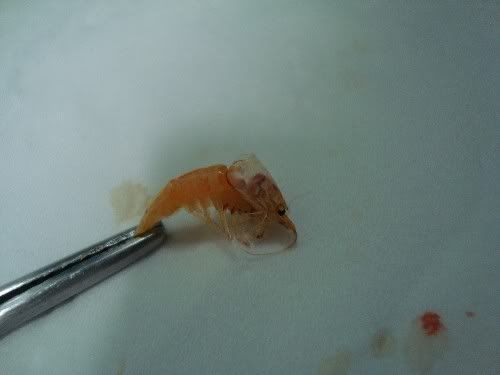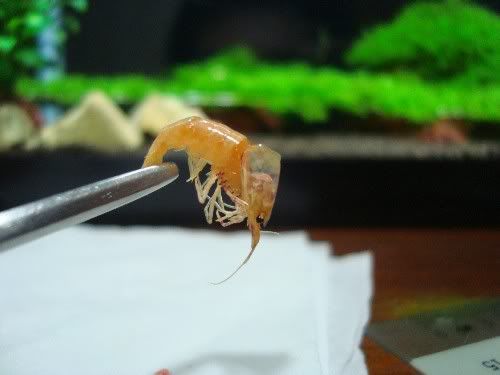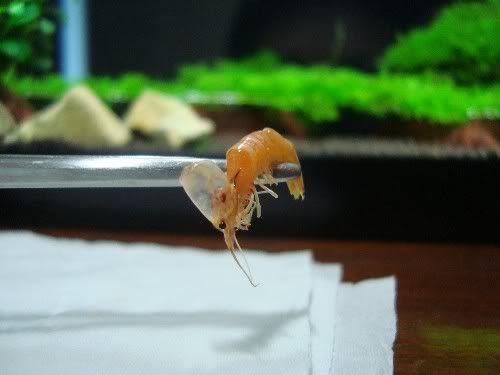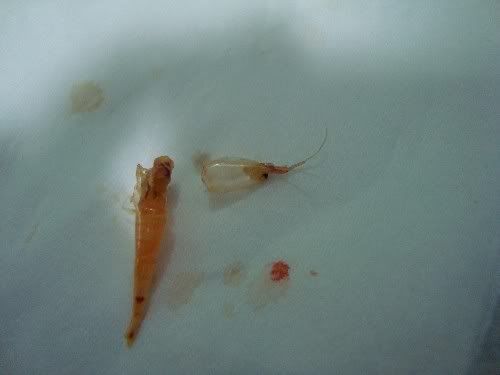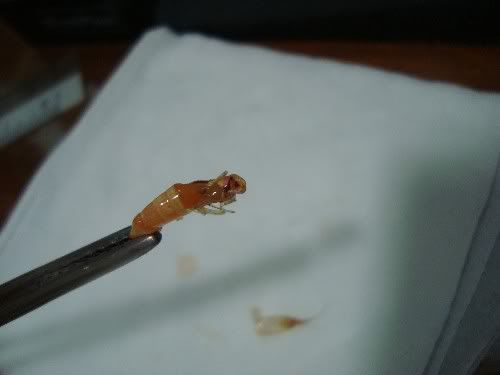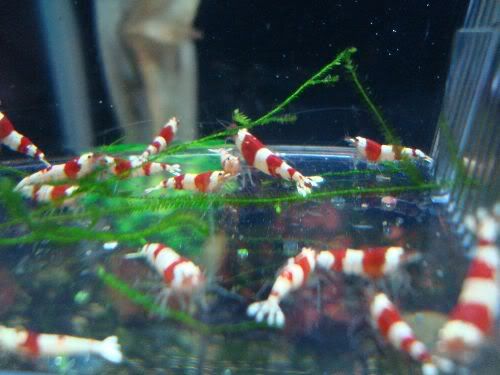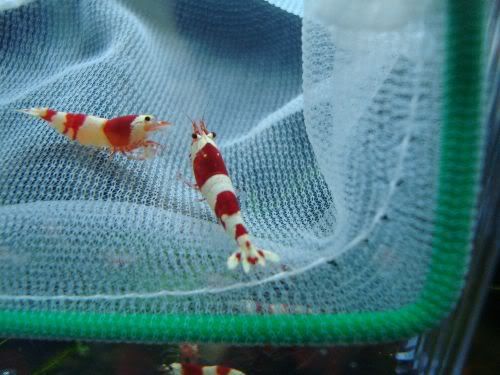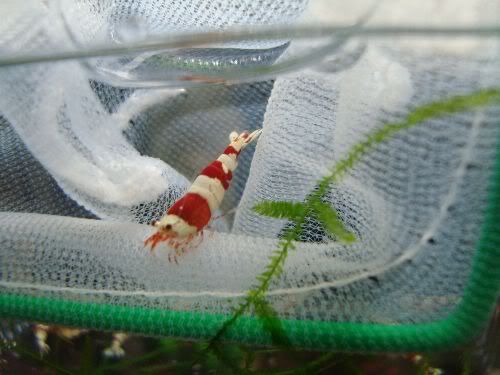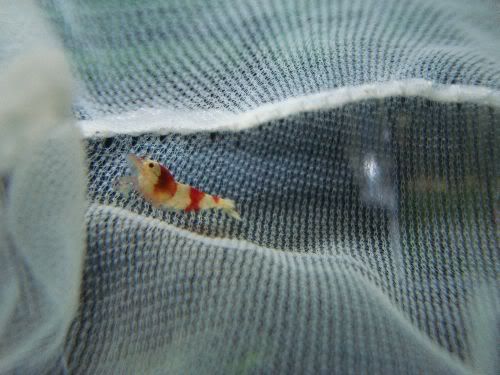This page is dedicated for short "bite size" articles on some of the shrimps that we fancy here at Shrimps Online. We hope that through these articles, the viewers and fellow shrimp hobbyists alike will be able to learn something and apply the knowledge for their own use.
Malayan Larvae Vs. CRS Shrimplets (Size DOES Matter)
For those that do not know how a malayan looks like, this is an adult female Malayan Shrimp. The females are more solid and darker but the males can be transparent.
I separated some berried Malayan shrimps into a separate tank to see how they gave birth and how their young, larvae/ shrimplets, will grow up.
Unlike the CRS/ BDS, a single female Malayan shrimp can hold and give birth anywhere from 50 - 100 eggs. The difference is that Malayans, instead of giving birth to live young shrimplets, they give birth to larvae! And ALOT of larvae. The berried female malayan shimp will be perched atop a small plant or rock and will be constantly kicking out larvae which will soon be floating all over your tank. The larvae will not attach themselves to the side of the wall or on anything but rather they will push themselves when they come into contact with anything. They will be free floating.
Some of the Malayan shrimp larvae.
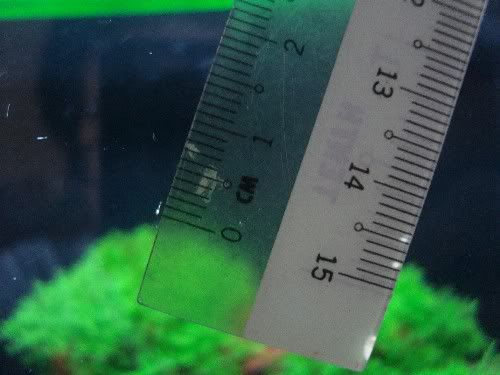 The Malayan shrimp larvae are so small, they are really just like a "fullstop" with a tail. They are smaller than 0.1cm as shown in the picture. The reason why this article mentioned "size does matter" because since these larvae were free floating, they were no match for the 700l/hr guzzling canister filter. Most of them were sucked straight into and through the very fine netting over the filter inlet which is 100% CRS/ BDS shrimplet safe.
The Malayan shrimp larvae are so small, they are really just like a "fullstop" with a tail. They are smaller than 0.1cm as shown in the picture. The reason why this article mentioned "size does matter" because since these larvae were free floating, they were no match for the 700l/hr guzzling canister filter. Most of them were sucked straight into and through the very fine netting over the filter inlet which is 100% CRS/ BDS shrimplet safe.
A newborn CRS shrimplet measures about 0.3cm. They will not get sucked into the filter with the fine netting that is put in place.
A quick check a few months later and behold! 1 or 2 Malayan shrimplets that managed to survive were spotted! However, seeing how long it takes for them to grow up from larvae to shrimplets and how hard it is to prevent them from getting sucked into the filter, plus considering how cheap they are, it is more worth it to buy them from the shops as you will be able to get a big bag of them for just a few dollars.
But just for the fun of it, this is an article for the Malayan Shrimp and their larvae.
A Dead Shrimp Vs. a Moulted Exoskeleton
I know this may sound a little silly but when i first started out in this hobby, i used to assume that an already dead shrimp was just in the process of moulting its shell or exo-skeleton. Only with expereince and after seeing a few "live" shrimps moulting, did i realise the difference between an already dead shrimp and one that is moulting. I hope this short write up will be useful to some beginners who might have the same thought which i had when i started out.
If you see a shrimp like the one in the picture, opaque or pale in color, it is NOT moulting but it is already dead. Remove it from the tank as it will start to foul the water.
On the other hand, this is an example of a moulted shell. It will be completely transparent and will be flimsy or fragile to the touch. You can leave the moulted shell in the tank as the shrimps will consume it for added calcium.
Ever Wondered What Makes Your Shrimps Tick?
Disclaimer - No shrimps were harmed for the making of this article but had already died a natural death. Let Shrimps Online show you the insides of the Crystal Red Shrimp. It is recommended that you are not eating anything as some of the pictures are quite graphic.
But first, here is a tribute to this beautiful Crown CRS:
Active when it was still alive
Malayan Larvae Vs. CRS Shrimplets (Size DOES Matter)
For those that do not know how a malayan looks like, this is an adult female Malayan Shrimp. The females are more solid and darker but the males can be transparent.
I separated some berried Malayan shrimps into a separate tank to see how they gave birth and how their young, larvae/ shrimplets, will grow up.
Unlike the CRS/ BDS, a single female Malayan shrimp can hold and give birth anywhere from 50 - 100 eggs. The difference is that Malayans, instead of giving birth to live young shrimplets, they give birth to larvae! And ALOT of larvae. The berried female malayan shimp will be perched atop a small plant or rock and will be constantly kicking out larvae which will soon be floating all over your tank. The larvae will not attach themselves to the side of the wall or on anything but rather they will push themselves when they come into contact with anything. They will be free floating.
Some of the Malayan shrimp larvae.
Free floating larvae.
 The Malayan shrimp larvae are so small, they are really just like a "fullstop" with a tail. They are smaller than 0.1cm as shown in the picture. The reason why this article mentioned "size does matter" because since these larvae were free floating, they were no match for the 700l/hr guzzling canister filter. Most of them were sucked straight into and through the very fine netting over the filter inlet which is 100% CRS/ BDS shrimplet safe.
The Malayan shrimp larvae are so small, they are really just like a "fullstop" with a tail. They are smaller than 0.1cm as shown in the picture. The reason why this article mentioned "size does matter" because since these larvae were free floating, they were no match for the 700l/hr guzzling canister filter. Most of them were sucked straight into and through the very fine netting over the filter inlet which is 100% CRS/ BDS shrimplet safe.A newborn CRS shrimplet measures about 0.3cm. They will not get sucked into the filter with the fine netting that is put in place.
A quick check a few months later and behold! 1 or 2 Malayan shrimplets that managed to survive were spotted! However, seeing how long it takes for them to grow up from larvae to shrimplets and how hard it is to prevent them from getting sucked into the filter, plus considering how cheap they are, it is more worth it to buy them from the shops as you will be able to get a big bag of them for just a few dollars.
But just for the fun of it, this is an article for the Malayan Shrimp and their larvae.
A Dead Shrimp Vs. a Moulted Exoskeleton
I know this may sound a little silly but when i first started out in this hobby, i used to assume that an already dead shrimp was just in the process of moulting its shell or exo-skeleton. Only with expereince and after seeing a few "live" shrimps moulting, did i realise the difference between an already dead shrimp and one that is moulting. I hope this short write up will be useful to some beginners who might have the same thought which i had when i started out.
If you see a shrimp like the one in the picture, opaque or pale in color, it is NOT moulting but it is already dead. Remove it from the tank as it will start to foul the water.
On the other hand, this is an example of a moulted shell. It will be completely transparent and will be flimsy or fragile to the touch. You can leave the moulted shell in the tank as the shrimps will consume it for added calcium.
Another picture of a moulted shell. I have had the chance to catch shrimps moulting but did not manage to catch it on camera. It is a very interesting process if you manage to catch it. The shrimp will usually swim up in mid water and will flick itself out of its old shell. The process is very quick. So, if you see the shrimp in a lifeless state (like in the first picture), it is dead.
Ever Wondered What Makes Your Shrimps Tick?
Disclaimer - No shrimps were harmed for the making of this article but had already died a natural death. Let Shrimps Online show you the insides of the Crystal Red Shrimp. It is recommended that you are not eating anything as some of the pictures are quite graphic.
But first, here is a tribute to this beautiful Crown CRS:
Active when it was still alive
This was taken when it just died
This CRS Crown shrimp has been used for the following "post-mortem" article. As a beginner to the hobby, i used to think that the beautiful patterns and coloration (red/ black) were present on the "shell" or exo-skeleton itself. If you have a similar thought, this article will be quite educational and may come as a surprise for some as well.
Here are just some shots of the shrimp out of the water:
Notice how the shrimp becomes more pale after it is dead. A dead shrimp also dries out very quickly once out of the water.
Side view
The underside of the shrimp. The shrimp has six legs with swimmerets from the mid part of the body to the tail end.
A full grown adult Crystal Red Shrimp can grow to about 2 - 2.5cm. This one is about 2cm.
The shrimp has two long feelers and it is natural for them to grow longer than the shrimp itself so that it can feel for objects behind itself. The one shown in the picture measures about 2.3 - 2.5cm
This shrimp which is about a fully grown adult is about 0.5cm in width.
Dissection of the shrimp:
The head or "shell" on the head section is rather fragile and unfolds rather easily and like the hood of a car, it flips open.
Another view with the shell on the head slightly flipped open.
You can see from this picture that the red pattern is actually a "substance-like" thick membrane inside of the shell it is "attached" to the inside wall of the shrimps shell.
When you scrap out the red membrane, the consistency is like a thick mucus (sorry for a lack of a better word to describe it) but when it is placed on the tissue as shown in the picture, it dissolves and becomes like a liquid. You will also notice that this leaves behind a clear "shell" or exo-skeleton.
Here is a clearer view of th insideof the shrimp or the flesh of the shrimp. You will also notice the vein that runs through the length of the shrimp's center.
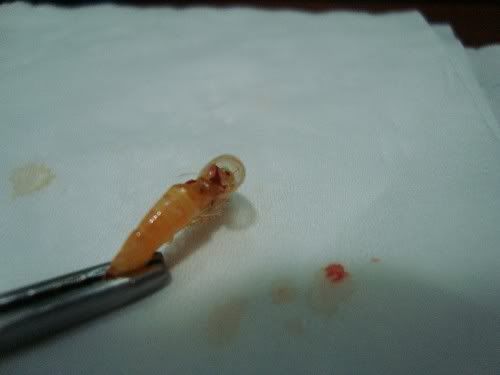 This is the inside of the head section. You can still see the remaining red "pattern" membrane and the "crown" pattern at the top.
This is the inside of the head section. You can still see the remaining red "pattern" membrane and the "crown" pattern at the top.This picture shows the head (shell) fully detached from the shrimp's body. Again, you can see that the shell is totally transparent.
We hope that this article has been educational and have helped you to understand the shrimp a little more. We hope also that you will not have to do this yourself as one thing is for sure, it sure smelled
Crystal Red Shrimp PRL (Pure Red Line)
Unlike the better known and common Crystal Red Shrimps (CRS), the Crystal Red Shrimp PRL boasts of a better quality in thickness of the whites and redness (deeper red) in coloration. This is attributed to the fact that the Pure Red Line as its name suggests, has not been crossed bred with the golden, snow white or the Black Diamond Shrimps (BDS). In simple terms, the genes of the Crystal Red Shrimp has not been diluted by other genes. Hence, their good and distinctive colouration.
This line of Crystal Red Shrimp PRL was started and selectively bred in Japan, Munechika Fish Farm (MFF), Nishiki (NSK), Hakataebi (HKT). Pure Red Line shrimps purchased from Japan or from any of the farms will be termed Japanese Pure Red Line or JPRL. However, now, there are many other breeders, farm and home, coming up in various parts of the world with their own breed outs you can term these just Pure Red Line (PRL). This has increased the availability of such shrimps but a good quality grade PRL can still fetch a high price.
In most cases, Crystal Red Shrimp PRL should have good and solid thickness of the whites and redness of the coloration. However, that also depends on the grade of the PRL. The PRL should also have full red or white legs but not always as some can have a pale redness or even transparent legs also depending on the grade. Most Crystal Red Shrimp PRL would be A/S grade (Bands, Vbands, Tiger tooth, Half hino), SS grade (Hinomaru or Hinomaru with no entry sign) and in very rare cases but still possible, SSS grades. It is rare to have an SSS grade as they have not been crossed with golden or snow whites.
As this Pure Red Line gene is carried by these shrimps, you can expect their offspring to carry the genetically red gene. Just like the Crystal Red Shrimp, the grade of the offspring will not be certain ranging from A/S to SS grades but the quality and coloration should be similar to that of their parents. Else, you can selective breed the better ones which is the recommended way to go for better quality and grade of shrimps.
The Crystal Red Shrimp PRL can be kept in similar tank conditions to that of the regular Crystal Red Shrimp i.e The pH, gH, water temperature should not be any different from the conditions of your CRS tank. Although, the CRS PRL and the regular CRS can live peacefully together, it is advised to separate the two as to sustain and maintain the PRL.
Comparison between the Crystal Red Shrimp PRL and the regular Crystal Red Shrimp:
Crystal Red Shrimp PRL band.
Young PRL.
An equivalent grade regular Crystal Red Shrimp.
Thank you for reading this short article on the Crystal Red Shrimps Pure Red Line (PRL). Please write in to us if you have further information that is beneficial for others or if you have any queries.
